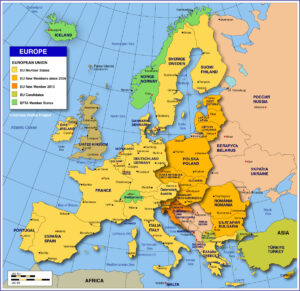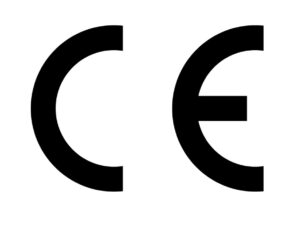2020-09-08: Ignoring Britain’s silly sabre-rattling, toothless threats and boorish blackmail attempts reported in the Media during this past weekend, yesterday and today … the actual state of play in the tortuous Brexit Negotiations can best be judged from the following sources …
Michel Barnier’s Presentation to the Institute for International and European Affairs (IIEA), on 2 September 2020 … View it Here on YouTube
Britain’s National Audit Office Report: ‘Learning for Government from EU Exit Preparations’, dated 4 September 2020 (Download PDF File, 197 Kb)
.

This is the European Union (EU), a Single Market of approximately 450 Million consumers. The EU operates under the freedoms and protections of Codified / Written Law, i.e. EU Treaties ratified by all of the EU Member States, EU Secondary Legislation (Regulations and Directives), and EU Administrative Provisions.
.
A suite of EU Regulations and Directives covers Industrial Products. While there is some flexibility with regard to how Directives are implemented at national level in the Member States, no such flexibility exists with Regulations. Construction Products can only be placed on the EU Single Market if they can be shown to comply with the requirements of the EU’s Construction Products Regulation (CPR) Framework, or in other words, be shown to be ‘fit for their intended use’ in the European Union …
REGULATION (EU) No 305/2011 of the European Parliament and of the Council, dated 9 March 2011, laying down harmonised conditions for the marketing of construction products and repealing Council Directive 89/106/EEC (Download PDF File, 998 Kb)
.

.
BREXIT ~ IMPLICATIONS FOR THE BRITISH FIRE INDUSTRY
Trade ‘No Deal’ or ‘Minimal Deal’ … from 1 January 2021, Great Britain will be completely outside the European Single Market, and the EU’s Construction Products Regulation Framework. The designation ‘Notified Body’ under that Framework will fall away from British Organizations. Construction Products/Systems manufactured in, or supplied from, Britain will then have to undergo an entirely new EU Testing and Approvals Programme in order to access the European Single Market. Fire Safety related Construction Products will have to be tested, and assessed or appraised, against all 7 Basic Requirements for Buildings together, during the same period of time (see Annex I, EU Regulation 305/2011) …
-
-
- Mechanical Resistance and Stability
- Safety in Case of Fire
- Hygiene, Health and the Environment
- Safety and Accessibility in Use
- Protection against Noise
- Energy Economy and Heat Retention
- Sustainable Use of Natural Resources
-
… a process which will be very interesting to observe, since the Fire Industry (particularly England’s Fire Establishment, AHJ’s, etc) dislikes, with intensity, the whole idea of ‘environmental impact’ … the concept of ‘sustainable development’ is hardly understood … and no consideration is given to the reasonable fire safety and accessibility needs of ‘vulnerable building users’ (including people with activity limitations, refugees, migrants, etc).
The tragic 2017 Grenfell Tower Fire, and its sad aftermath, have demonstrated how dysfunctional, and rotten to the core, is the whole national system of Building Fire Safety in England. More than 3 years later … on the evidence to date of an ongoing, incompetent Inquiry and a series of shoddy responses from Government … will survivors and the victims’ families ever receive Justice, and find Peace ? cf. The 1981 Stardust Discotheque Fire in Dublin. Survivors and victims’ families are still waiting for the truth to be revealed.
In parallel, mutual recognition of British Professional Building Designers, e.g. Architects, Structural Engineers, Fire Engineers, etc., within the European Union will cease.
In parallel, British Fire Research involvement in EU Research Networks will also cease … unless a heavy price is paid to be involved as a 3rd Country. British Institutions should forget any notions they might have about Network Leadership.
In parallel, Information and Data Flows between Britain and the EU will be disrupted or cease altogether … unless Britain complies fully with the requirements of EU General Data Protection Regulation (GDPR) 2016/679. As a vassal state of the USA, this compliance may prove difficult for Britain !
.
EU Fire Safety Related Product/System Manufacturers ~ A Word of Caution !
Many EU Construction Product/System Manufacturers continue to use the services provided by British Fire Test Laboratories and/or Fire Consultancy Organizations located in Great Britain … some of which have already established EU-based dummy companies and letterheads. These British organizations must be avoided altogether. For example, the practice of fire testing in England and later adding a title page of a Full Test Report with an EU location address is entirely unacceptable !
.
.
END
#Twitter … @walshcj69 …
#Sustainability #Brexit #EU #England #MichelBarnier #GB #PerfidiousAlbion #ConstructionProducts #FireSafety4ALL #VulnerableBuildingUsers #EnvironmentalImpact #SustainableDevelopment #BrexitTrainCrash #BorisCummings #BuildingDesigners #FireEngineers #Architects #Turkey #Scotland #EuropeanUnion #NationalAuditOffice #NobodyLeftBehind #TechnicalControl #FireCodes #SFE #SIA #SustainableFireEngineering #Resilience #Reliability #GrenfellTowerFire #StardustDiscoFire #Dublin #CEmark #FireResearch #GDPR #IIEA #CPRframework #MutualRecognition #Russia #USA #CodifiedLaw #EUtreaties #PwAL

